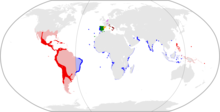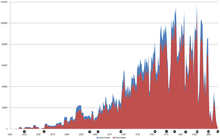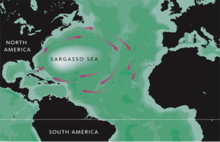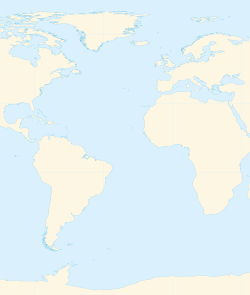Human origin
Humans evolved in Africa; first by diverging from other apes around 7 Ma; then developing stone tools around 2.6 Ma; to finally evolve as
modern humans around 100 kya. The earliest evidences for the complex behaviour associated with this
behavioral modernity has been found in the Greater
Cape Floristic Region (GCFR) along the coast of South Africa. During the latest glacial stages the now-submerged plains of the
Agulhas Bank
were exposed above sea level, extending the South African coastline
farther south by hundreds of kilometres. A small population of modern
humans — probably fewer than a thousand reproducing individuals —
survived glacial maxima by exploring the high diversity offered by these
Palaeo-Agulhas plains. The GCFR is delimited to the north by the
Cape Fold Belt
and the limited space south of it resulted in the development of social
networks out of which complex Stone Age technologies emerged.
[52] Human history thus begins on the coasts of South Africa where the Atlantic
Benguela Upwelling and Indian Ocean
Agulhas Current meet to produce an intertidal zone on which shellfish, fur seal, fishes and sea birds provided the necessary protein sources.
[53] The African origin of this modern behaviour is evidenced by 70,000 years-old engravings from
Blombos Cave, South Africa.
[54]
Old World
Mitochondrial DNA
(mtDNA) studies indicate that 80–60,000 years ago a major demographic
expansion within Africa, derived from a single, small population,
coincided with the emergence of behavioural complexity and the rapid
MIS 5–4 environmental changes. This group of people not only expanded over the whole of Africa, but also started to disperse
out of Africa into Asia, Europe, and Australasia around 65.000 years ago and quickly replaced the archaic humans in these regions.
[55] During the
Last Glacial Maximum
(LGM) 20,000 years ago humans had to abandon their initial settlements
along the European North Atlantic coast and retreat to the
Mediterranean. Following rapid climate changes at the end of the LGM
this region was repopulated by
Magdalenian culture. Other hunter-gatherers followed in waves interrupted by large-scale hazards such as the
Laacher See volcanic eruption, the inundation of
Doggerland (now the
North Sea), and the formation of the
Baltic Sea.
[56] The European coasts of the North Atlantic were permanently populated about 9–8.5 thousand years ago.
[57]
This human dispersal left abundant traces along the coasts of the Atlantic Ocean. 50 ka-old, deeply stratified
shell middens found in
Ysterfontein
on the western coast of South Africa are associated with the Middle
Stone Age (MSA). The MSA population was small and dispersed and the rate
of their reproduction and exploitation was less intense than those of
later generations. While their middens resemble 12-11 ka-old Late Stone
Age (LSA) middens found on every inhabited continent, the 50-45 ka-old
Enkapune Ya Muto in Kenya probably represents the oldest traces of the first modern humans to disperse out of Africa.
[58]
The same development can be seen in Europe. In
La Riera Cave
(23-13 ka) in Asturias, Spain, only some 26,600 molluscs were deposited
over 10 ka. In contrast, 8-7 ka-old shell middens in Portugal, Denmark,
and Brazil generated thousands of tonnes of debris and artefacts. The
Ertebølle middens in Denmark, for example, accumulated 2,000 m
3
(71,000 cu ft) of shell deposits representing some 50 million molluscs
over only a thousand years. This intensification in the exploitation of
marine resources has been described as accompanied by new technologies —
such as boats, harpoons, and fish-hooks — because many caves found in
the Mediterranean and on the European Atlantic coast have increased
quantities of marine shells in their upper levels and reduced quantities
in their lower. The earliest exploitation, however, took place on the
now submerged shelves, and most settlements now excavated were then
located several kilometres from these shelves. The reduced quantities of
shells in the lower levels can represent the few shells that were
exported inland.
[59]
New World
During the LGM the
Laurentide Ice Sheet covered most of northern North America while
Beringia connected Siberia to Alaska. In 1973 late U.S. geoscientist
Paul S. Martin proposed a "blitzkrieg" colonization of America by which
Clovis hunters
migrated into North America around 13,000 years ago in a single wave
through an ice-free corridor in the ice sheet and "spread southward
explosively, briefly attaining a density sufficiently large to overkill
much of their prey."
[60] Others later proposed a "three-wave" migration over the
Bering Land Bridge.
[61] These hypotheses remained the long-held view regarding the
settlement of the Americas,
a view challenged by more recent archaeological discoveries: the oldest
archaeological sites in the Americas have been found in South America;
sites in north-east Siberia report virtually no human presence there
during the LGM; and most Clovis artefacts have been found in eastern
North America along the Atlantic coast.
[62] Furthermore, colonisation models based on mtDNA,
yDNA, and
atDNA
data respectively support neither the "blitzkrieg" nor the "three-wave"
hypotheses but they also deliver mutually ambiguous results.
Contradictory data from archaeology and genetics will most likely
deliver future hypotheses that will, eventually, confirm each other.
[63]
A proposed route across the Pacific to South America could explain
early South American finds and another hypothesis proposes a northern
path, through the Canadian Arctic and down the North American Atlantic
coast.
[64]
Early settlements across the Atlantic have been suggested by
alternative theories, ranging from purely hypothetical to mostly
disputed, including the
Solutrean hypothesis and some of the
Pre-Columbian trans-oceanic contact theories.
Based on the medieval
Íslendingasögur sagas, including the
Grœnlendinga saga, this interpretative map of the "Norse World" shows that Norse knowledge of America and the Atlantic remained limited.
The
Norse settlement of the
Faroe Islands and
Iceland began during the 9th and 10th centuries. A settlement on
Greenland was established before 1000 CE, but contact with it was lost in 1409 and it was finally abandoned during the early
Little Ice Age.
This setback was caused by a range of factors: an unsustainable economy
resulted in erosion and denudation, while conflicts with the local
Inuit
resulted in the failure to adapt their Arctic technologies; a colder
climate resulted in starvation; and the colony got economically
marginalised as the
Great Plague and
Barbary pirates harvested its victims on Iceland in the 15th century.
[65]
Iceland was initially settled 865–930 CE following a warm period when
winter temperatures hovered around 2 °C (36 °F) which made farming
favourable at high latitudes. This did not last, however, and
temperatures quickly dropped; at 1080 CE summer temperatures had reached
a maximum of 5 °C (41 °F). The
Landnámabók (
Book of Settlement)
records disastrous famines during the first century of settlement —
"men ate foxes and ravens" and "the old and helpless were killed and
thrown over cliffs" — and by the early 1200s hay had to be abandoned for
short-season crops such as barley.
[66]











